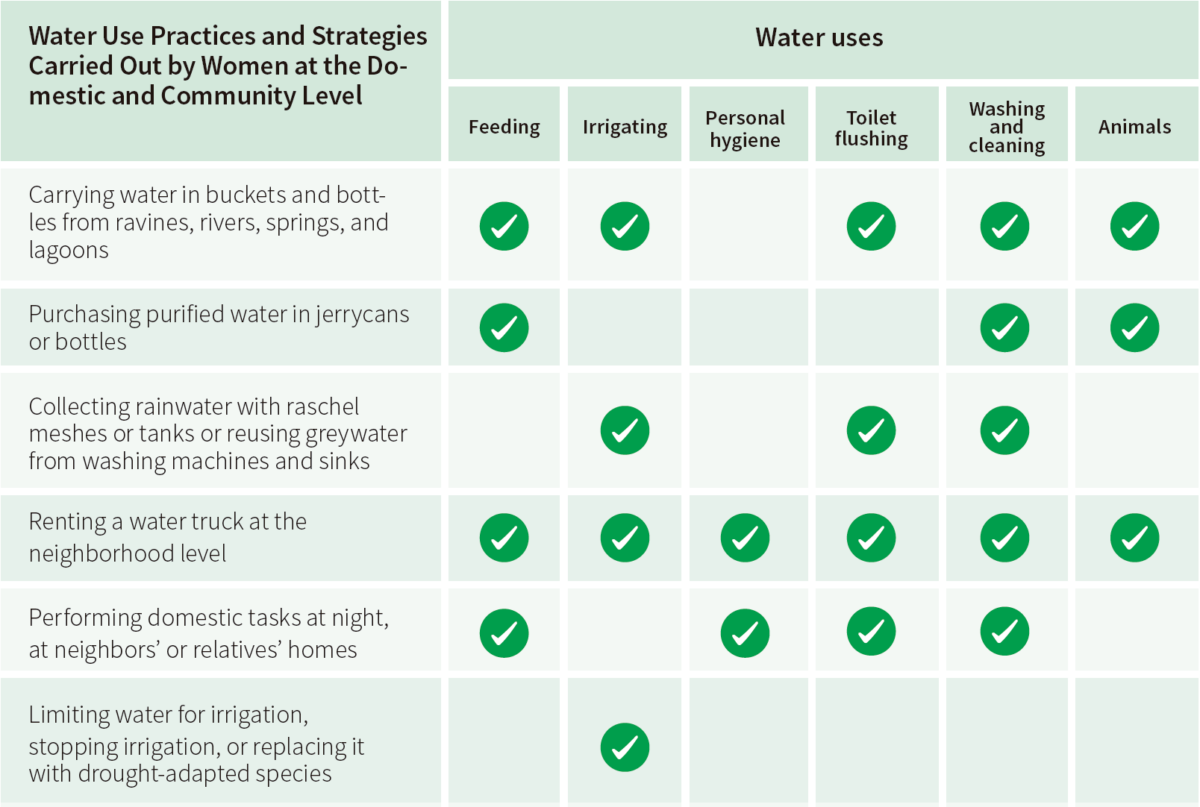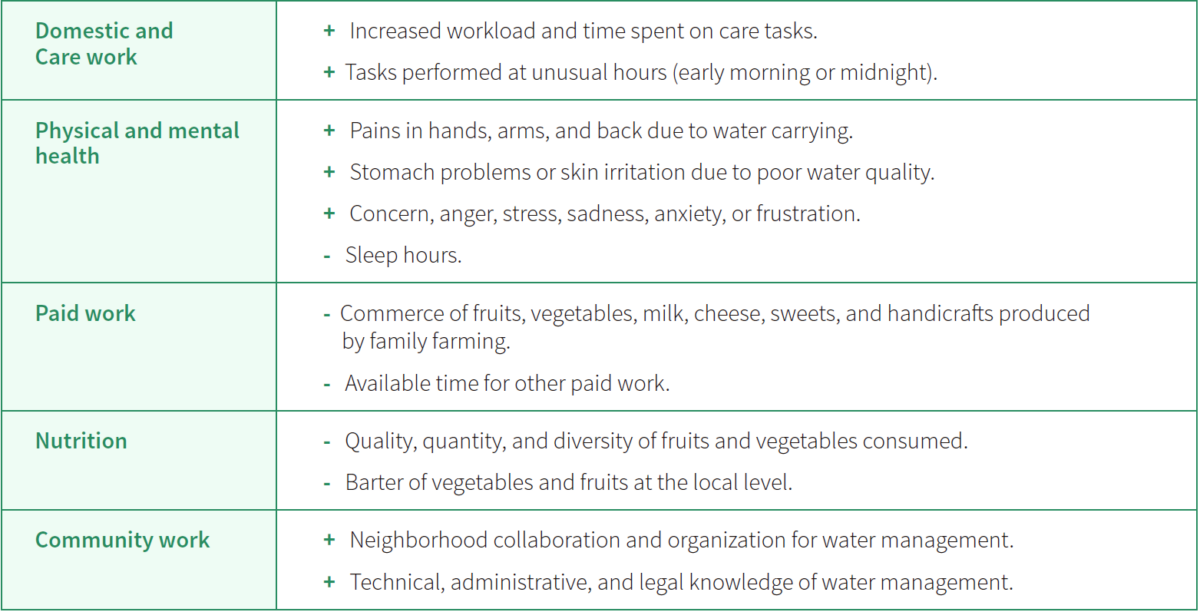Macarena Salinas, Training Coordinator at CR2; Isaura Becker, Ph.D. Candidate in Social Sciences at the University of Tarapacá; María Christina Fragkou, Adjunct Researcher at CR2; and Anahí Urquiza, Associate Researcher at CR2.
- Women play a central role in domestic and care work in rural areas. Hence, in conditions of water insecurity, they are primarily responsible for accessing and managing water within their households.
- Water insecurity leads to increased domestic and care work burdens, which impact women’s physical and mental health, nutrition, and paid and community work.
- Women contribute valuable knowledge that must be integrated into climate change adaptation strategies, offering an opportunity to transform traditional gender roles in water management.
Due to the megadrought affecting the country since 2010, most basins between Coquimbo and Maule have experienced high levels of water stress (Álvarez-Garreton et al., 2023). This situation has been exacerbated by the excessive use of water for productive purposes and a regulatory and governance framework that does not favor integrated basin-scale management, promotes privatization, and lacks state-led planning and protection tools (Billi et al., 2021). This hinders the satisfaction of the needs of rural communities, which are the most affected by water scarcity (Fragkou et al., 2022). 46% of the rural population depends on community or individual management systems to obtain water, using groundwater and surface water sources or resorting to water trucks when these are depleted (Álvarez et al., 2023). In this context, the challenge of advancing towards water security in the territories becomes increasingly complex.
Water security is understood as “the capacity of a territory to ensure equitable access – in quality and quantity – to resilient water services that enable the sustainable human and economic development of its population” (Urquiza & Billi, 2020). Within this framework, it becomes relevant to analyze water security from a gender perspective, considering that in territories affected by the scarcity of drinking water, women and girls are the main group responsible for finding solutions to access and manage water within their households (WWAP, 2019). This relates to their historical role in domestic and care tasks that depend on water, such as childcare, caring for the sick or elderly, feeding, and hygiene. Furthermore, vulnerability varies according to inequities linked to gender, ethnicity, low income, and other patterns of inequality (IPCC, 2023). On the other hand, women tend to express deeper concerns about addressing climate change and a greater perception of responsibility for the cause and seeking solutions (Centro de Ciencia del Clima y la Resiliencia CR2 and StatKnows, 2019).
What happens in women’s daily lives when water is insufficient to meet the most basic needs? How do they develop strategies to address these problems? The book *Guardianas del agua: (in)seguridad hídrica en la vida cotidiana de las mujeres* (Guardians of Water: (In)Security in the Daily Life of Women) explores this reality in rural central Chile, through 31 interviews with women[1] who lack safe water in 16 municipalities of the country, between the regions of Coquimbo and Maule. This document aims to present the main results of this research and establish policy recommendations for inclusive, sustainable, and gender-responsive integrated water management.
Main Problems in Domestic Water Management in the Context of Water Insecurity
Various daily problems that affect domestic water management were identified, demonstrating conditions of water insecurity in households that lack sufficient water in terms of quantity, quality, affordability, or acceptability. This situation is exacerbated in households with fewer resources. The main problems identified are:
- Pressure: Insufficient water pressure is related to low water availability in supply networks and poor water infrastructure. It occurs when pipes leak, or the flow rate is not high enough to achieve optimal pressure.
- Water Cuts: Water cuts occur when household supply is restricted, affecting the continuity of use. They can occur at certain time intervals, for days or weeks. These cuts can be scheduled by Rural Sanitary Services (SSR) or unplanned.
- Water Quality and Reliability of the Source: Distrust in water quality is associated with supply from water trucks or the impacts of landfills, mining tailings, pesticides, or certain contamination events on water sources. Distrust is present in some of the following cases: 1) Greenish coloration due to untreated organic material (moss, larvae, or worms), 2) turbidity due to the entry of sediments into the pipes or tanks, or 3) brackish or excessive chlorine taste, among others.
- Economic Costs: Refers to the economic expenditure that families incur to buy drinking water or to improve household infrastructure to obtain it. The additional expenses that households must make include: 1) Purchasing bottled water for direct consumption, 2) purchasing new domestic water infrastructure, such as tanks, pipes, and pumps, plus the associated costs of their repairs, maintenance, and cleaning, 3) deepening wells, and 4) renting water trucks to distribute water at the neighborhood level.
Strategies and Water Use Practices Carried Out by Women
The women surveyed in the research indicate that it is impossible to meet individual and family needs in water insecurity conditions. To address this situation, they implement various strategies that reveal the use of different types of water in the same household, each destined for specific uses. For example, they usually buy bottled water for family consumption and their animals. At the same time, irrigation, toilet flushing, and household cleaning are often carried out with reused or stored water in small tanks.
The research identified 16 practices and strategies, and the most common are mentioned below:
 Effects of Water Insecurity on the Daily Life of Women
Effects of Water Insecurity on the Daily Life of Women
Water insecurity has a significant impact on women’s daily lives. First, there are muscle pains and skin problems due to transporting, storing, and reusing water. Furthermore, this responsibility results in them experiencing stress, sadness, and anger at not having access to safe water for their families and communities. Secondly, it limits family farming, making it difficult to be self-sufficient in food and reducing the quantity, quality, and variety of food consumed. This forces them to turn to new markets, increasing economic expenses and affecting family income. In addition, local enterprises that depend on vegetable gardens and trees are negatively impacted.
In addition, there is an increase in community collaboration strategies. Women play a leading role in activities such as “Water Mingas” (collective work parties), where collective solutions are sought in the face of a lack of state support. In these processes, women acquire technical, administrative, and legal knowledge about water management. Nevertheless, they face challenges such as a lack of recognition of their work and the preference for male opinions in decision-making.
Table 1 shows the consequences generated by water insecurity in the different areas of women’s daily life:
Table 1: Effects of Water Insecurity on the Daily Life of Women
Recommendations
Due to Chile’s territorial diversity, no single strategy can be applied standardized. Therefore, it is crucial to consider the implementation of measures adapted to the different territories to address water gaps with an intersectional gender approach. According to the research results, the following recommendations for public policy are formulated:
- The State needs to increase its planning and protection tools, focusing on improving drinking water and sanitation infrastructure in rural areas, implementing programs that address technological gaps and access to financing for SSR, and strengthening watershed protection.
- Promote training in gender and water management in SSR, strengthen the formation of gender-focused teams in institutions related to water management (General Water Directorate, Directorate of Hydraulic Works, Superintendency of Sanitary Services, National Irrigation Commission, among others), and promote interdisciplinary work to address these issues comprehensively and systematically.
- Facilitate the creation of community participation spaces to share local knowledge for climate change adaptation. Both academia and public and private institutions must incorporate this knowledge, along with the strategies used by women, as they are fundamental to challenging entrenched gender roles in water management.4. It is essential to recognize the diversity within a group of women when addressing their experiences related to water management, so it is recommended to adopt an intersectional approach in these analyses. This framework recognizes that experiences of inequality are shaped by various factors, such as socioeconomic status, age, urban or rural environment, and ethnicity, which configure different realities of water insecurity.
- Progress must be made in research and collecting gender-disaggregated data to assess local water insecurity gaps, prioritizing the most vulnerable rural sectors. Strengthening research on the impacts of water scarcity on women and exploring the consequences for men and LGBTTTIQ+ people is crucial.
- Implementing measures guaranteeing women’s effective participation in water management at all levels is essential. Evaluating progress toward gender equity should not be limited to counting the number of women involved. Still, it should also address the barriers and inequalities they face, such as discrimination, harassment, gender division of labor, and difficulties influencing decision-making.
Notes
[1] The sample included women aged 26 to 98, from various professions and occupations. Each participant was interviewed individually and, later, a process of transcription, editing and validation of their life stories was carried out in collaboration with them, following an informed consent protocol. In addition, a content analysis was used to identify the main challenges in domestic water management, the strategies and practices adopted by women to address them, as well as the impacts of water insecurity on their daily life.
References
Alvarez-Garreton, C., Boisier, J.P., Blanco, G., Billi, M., Nicolas-Artero, C., Maillet, A., Aldunce, P., Urrutia-Jalabert, R., Zambrano-Bigiarini, M., Guevara, G., Galleguillos, M., Muñoz, A., Christie, D., Marinao, R., & Garreaud, R. (2023). Seguridad Hídrica en Chile: Caracterización y Perspectivas de Futuro. Centro de Ciencia del Clima y la Resiliencia CR2, (ANID/FONDAP/1522A0001), 72 pp. www.cr2.cl/seguridadhidrica
Billi, M., Moraga, P., Aliste, E., Maillet, A., O’Ryan, R., Sapiains, R., Bórquez, R., Aldunce, P., Azócar, G., Blanco, G., Carrasco, N., Galleguillos, M., Hervé, D., Ibarra, C., Ibarra, C., Gallardo, L., Inostroza, V., Lambert, F., Manuschevic, D., Martínez, F., Osses, M., Rivas, N., Rojas, M., Seguel, R., Tolvett., S., & Ugarte, A. (2021). Gobernanza Climática de los Elementos. Hacia una gobernanza climática del Agua, el Aire, el Fuego y la Tierra en Chile, integrada, anticipatoria, socio-ecosistémica y fundada en evidencia. Centro de Ciencia del Clima y la Resiliencia (CR)2, (ANID/FONDAP/15110009), 69 pp. www.cr2.cl/gobernanza-elementos/
Centro de Ciencia del Clima y la Resiliencia CR2 & StatKnows. (2019). Informe de resultados: Encuesta Internacional de Cambio Climático 2019. https://www.statknows.com/_files/ugd/766c75_188c216224124cdbb5ecb6f4ed8554f2.pdf
IPCC. (2023). Summary for Policymakers. In: Climate Change 2023: Synthesis Report. Contribution of Working Groups I, II and III to the Sixth Assessment Report of the Intergovernmental Panel on Climate Change [Core Writing Team, H. Lee and J. Romero (eds.)]. IPCC, Geneva, Switzerland, pp. 1-34, doi: 10.59327/IPCC/AR6-9789291691647.001
Fragkou, M., Monsalve-Tapia, T., Pereira-Roa, V., & Bolados Arratia, M. (2022). Abastecimiento de agua potable por camiones aljibe durante la megasequía. Un análisis hidrosocial de la provincia de Petorca, Chile. EURE – Revista de Estudios Urbano Regionales, 48(145). 10.7764/EURE.48.145.04
Salinas, M., & Becker, I. (2022). Guardianas del agua: (in)seguridad hídrica en la vida cotidiana de las mujeres. Fundación Heinrich Böll.
Urquiza, A., & Billi, M. (2020). Seguridad hídrica y energética en América Latina y el Caribe: definición y aproximación territorial para el análisis de brechas y riesgos de la población. Documentos de Proyectos (LC/TS.2020/138), Santiago, Comisión Económica para América Latina y el Caribe (CEPAL).
WWAP (Programa Mundial de Evaluación de los Recursos Hídricos de la UNESCO). (2019). Informe Mundial de las Naciones Unidas sobre el Desarrollo de los Recursos Hìdricos 2019: No dejar a nadie atrás. París, UNESCO.





